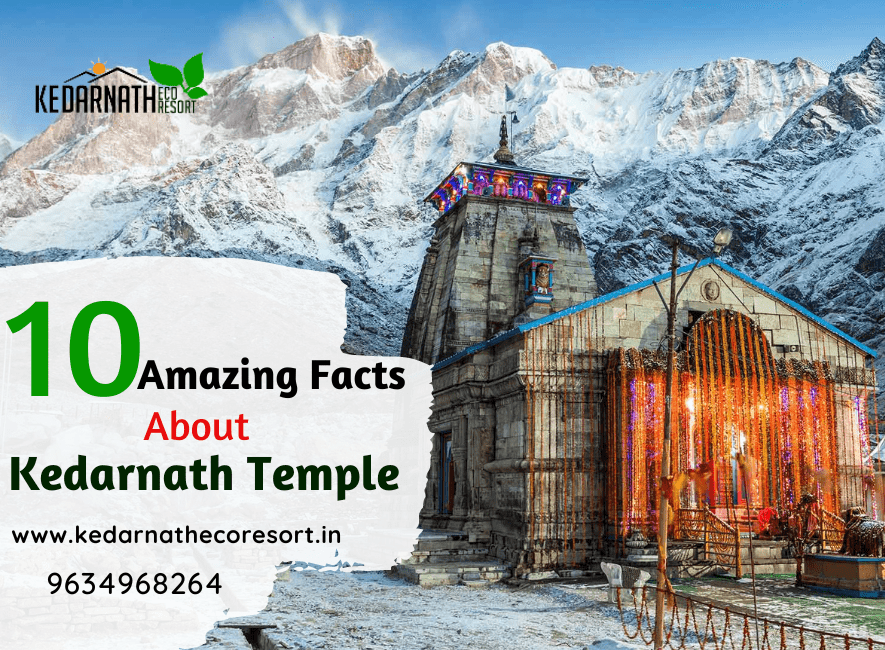10 Facts about Kedarnath Temple that will amaze you!
One of the most significant sanctuaries in the Hindu religion is Kedarnath. It is situated in Uttarakhand next to the Chorabari Glacier at a height of 3583 feet above sea level on the banks of the River Mandakini.
For 400 years the temple remained buried inside the snow and survived. One of India’s 12 Jyotirlingas, Kedarnath Temple has been important since the time of the Mahabharata epic. One of the four main pilgrimage sites in India is Kedarnath, which is located in Uttarakhand’s Northern Himalayas. In addition to having great significance for Hinduism, Kedarnath also has some legends related with it.
The hallowed Dham of Lord Shiva, Kedarnath Temple, is among the most essential components of the Uttarakhand Chardham Yatra.
Devotees from all over the world travel to Uttarakhand every year in search of Moksha, or the experience of spiritual ecstasy. When it comes to receiving darshan at Hindu pilgrimage locations, it is among the most challenging Yatras and spiritual endeavors.
Kedarnath is thought to be a location where karma is cleansed and desires are granted. This temple, as lovely as it is, thought to contain some enigmatic and unexpected facts. We will now examine some interesting facts about Kedarnath Temple before moving on.
Mysterious Facts about Kedarnath Temple that makes is so Unique
The temple is guarded by the lord himself.
Lord Shiva guards the Kedarnath shrine. As we all know what happened in Kedarnath due to intense monsoon rains in 2013 resulted in landslides and floods, which completely destroyed Kedarnath’s surroundings. The Kedarnath temple stayed unharmed, as if a spiritual force was keeping it from being destroyed, despite the fact that many villagers and pilgrims perished the same year due to the destruction of nature.
The Kedarnath Mandir was preserved, according to some who saw it, because of a large boulder that blocked the back of the mandir and caused the water and debris to divert their route.
Udak Kund’s relationship to the Kedarnath Temple
It is said that if a person ingests Udak Kund’s holy water before passing away, they will be forever free from the karmic cycle of life and death. Water bears the most spiritual value in the Himalayas, making this one of the most astonishing facts about Kedarnath Temple.
Given that water is the most revered element in the Himalayas, it is perhaps one of the most intriguing facts about Kedarnath Temple. In Kedarnath, Mother Ganga was conceived.
The origin of the Kedarnath Temple
According to legend, the Pandavas wished to atone for their crimes after the Mahabharata war because they felt bad about killing their family members.
They begged Lord Shiva to absolve them of their misdeeds in an effort to get forgiveness, but Lord Shiva persisted in keeping his distance. Finding Lord Shiva was difficult for them because he was under the ground and just his bulge was visible, making it harder for them to seek forgiveness.
Bhim, one of the pandavas, pulled the buffalo from the earth, and as soon as he did, it merged with the Linga that was already there. The Pandavas saw Lord Shiva, who absolved them of their crimes. This is how the Kedarnath lingam, which has the appearance of a mountain rock shaped like a pyramid, was created.
Adi Shankaracharya and the Kedarnath Temple
Adi Shankaracharya, the originator of India’s four sacred dhams, is buried behind the Kedarnath Temple. At age 32, he gained nirvana. He allegedly fused with the Kedarnath region and permanently united himself with God. And provide comfort from the harsh weather in the area, he also built a math and a hot spring.
Defense against demons
The prevailing belief is that Bhairon Nath ji banishes evil spirits and protects the temple from harm. It is situated south of Kedarnath Temple and also goes by the name of Bhairon Baba Mandir. In fact, it’s fascinating to learn that, as part of the ceremony, visitors visiting the Kedarnath Temple must also go to the Bhairon Baba ka Mandir.
There is something unique about the priests.
The temple’s chief priest, known as a Rawal, is a member of Karnataka’s Veera Shaiva Jangam community.
The rites inside the temple are not carried out by the Rawal, or top priest. His assistants are given this duty by him.
Kannada is used to do the actual puja. It is a tradition that has been observed inside the temple for many years.
The Earthly manifestation of the divinity Vishnu, Nara-Narayana
The two Lord Vishnu avatars Nar and Narayana are said to have worshipped a Shivalingam that beautifully rose out of the ground when they performed a difficult deed of fasting in the Badrikashraya of Bharat Khand. Lord Shiva was afterwards pleased, and he appeared before Nar and Narayana and asked them to find a gift.
Then Nar and Narayana begged to Lord Shiva to remain a Jyotirlingam at Kedarnath indefinitely so that everyone who visits to worship Lord Shiva here will no longer be bound by life’s woes.
Facts about Kedarnath disaster
Anyone trying to go to Kedarnath swiftly may have difficulty due to the unpredictability of the weather. We are all familiar with the fact about Kedarnath tragedy in 2013, which was mostly caused by severe flooding and resulted in extensive destruction. It was a miracle that nothing happened to the temple.
No matter how big an event is, according to certain religious experts, nothing is going able to happen at this sacred temple because the primary god watches over it. This was made clear by the 2013 Kedarnath disaster, which mostly spared Kedarnath’s temple while wreaking havoc on the town’s surroundings.
The name “Kedarnath” fact
An intriguing fact about the temple is that the word “Kedarnath” has a Charhe origin. When they were besieged by demons in the past, the gods allegedly sought Lord Shiva’s protection. I am Lord Shiva, he said to the “Kodarum” as he arrived as a bull (whom to rip and tore apart).
He threw the dead demons into to the Mandakini River after smashing them with his horns and hooves. The name Kedarnath was taken from this origin.
Meaning in Mythology of Kedarnath Temple
One of the older Shiva temples, Kedarnath Temple, is still a popular destination for tourists and worshippers because of its mythological significance.
In the Koti Rudra Samhita of the Shiva Purana, there is a fascinating story that is mentioned. It says that in the village of Badrika, Nar and Narayan, twin brothers and avatars of Lord Vishnu, built a makeshift shivling to worship Lord Shiva. In their hard penance, which included standing on one leg for a very long time, they were punished.
When Lord Shiva finally showed up, he was moved by their unwavering dedication and strict penance and he prompted them to fulfill a wish. Lord Shiva was requested to make this location his permanent dwelling by Nar and Narayan in his original form.
Conclusion
There are many intriguing things and unknown facts about Kedarnath. Numerous wildlife species, including those that are endangered, call Kedarnath home. Given the variety of birds that may be spotted there, the area is a sanctuary for birdwatchers.
There are several routes to explore in Kedarnath, making it an excellent site for hiking and camping. As a result, make sure to include Kedarnath on your list if you’re seeking for a destination that is rich in culture, history, and scenic beauty.




